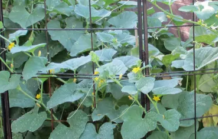https://hnr.k-state.edu/extension/info-center/newsletters/index.html
Blog Post: http://www.ksuhortnewsletter.org
Video of the Week: Overseeding Your Lawn
https://www.youtube.com/watch?v=DQoQ9mCWw5s
REMINDERS
• Harvest winter squash when skin is hard enough that it is not easily punctured with a thumbnail.
• Remove small tomatoes from vines to encourage development of more mature fruits.
• Plant garden chrysanthemums for fall color.
VEGETABLES
Asparagus and Rhubarb in the Autumn Season
Harvest is long past but now is the time asparagus and rhubarb plants build up needed reserves for the next year. Be sure to water during dry weather and keep plants free of weeds. Rhubarb should not be fertilized now but in early spring (March). Do not fertilize asparagus now or in early spring but rather wait until after harvest next year.
Asparagus foliage should be left until all green is gone. It can then be removed or left for the winter to help collect snow. (Ward Upham)
Harvesting and Roasting Sunflower Seed
Sunflowers are usually ready to be harvested beginning in mid-September and into October. Seed heads can ripen on the plant, but they will need protection from birds. Try covering the heads with a paper sack or cheesecloth once the petals start turning brown. Use a twist tie or rubber band to secure the covering. This will not only help keep birds out but will prevent ripened seeds from dropping out of the head. Check for maturity by looking for the following signs:
– Florets in the brown center of the flower disk should be shriveled.
– Heads should have turned down.
– The backside of the head should be lemon yellow.
The ultimate check, of course, is to pull a few seeds to see if they have turned black with white stripes, the typical color. Empty shells usually indicate a lack of pollination earlier in the year. If heads are to remain uncovered, harvest when a few seeds start turning black and white. The flavor will not be good as when seeds are allowed to ripen on the plants, but fewer seeds will be lost.
Cut the heads and place in a paper sack. Some people prefer to cut the heads with about a foot of stem attached and hang them upside down in a dry, well-ventilated area. A paper bag or cheesecloth can be placed over the heads to prevent seeds from dropping as they dry. Seeds can be easily removed from dry heads by rubbing gently.
Roasting Seeds
Raw, mature seeds may be prepared at home by covering unshelled seeds with salted water (2 quarts of water to 1/4 to 2 cup salt). Bring to a boil and simmer 2 hours, or soak in the salt solution overnight. Drain and dry on absorbent paper.
Put sunflower seeds in a shallow pan in a 300-degree F oven for 30 to 40 minutes or until golden brown, stirring occasionally. Take seeds out of the oven and add 1 teaspoon of melted butter or margarine, or cooking oil per 1 cup of seeds if they are to be eaten immediately. Stir to coat. Put on an absorbent towel. Salt to taste. (Ward Upham)
MISCELLANEOUS
Reblooming Christmas and Thanksgiving Cacti
Christmas Cactus (Schlumbergera bridgesii) and Thanksgiving Cactus (Schlumbergera truncate) are popular flowering holiday plants. Both are epiphytes native to the jungles of South America. Epiphytic plants grow on other plants and use them for support but not for nutrients. Though these cacti are different species, they will hybridize and produce varying stem shapes. Christmas cactus normally has smooth stem segments. Thanksgiving Cactus has hook-like appendages on each segment.
Flowering will not occur unless induced by temperature and light treatment. If the temperature is held at 50 to 55 degrees F, flowering will occur regardless of day length. But flowering usually is not uniform. Temperatures below 50 degrees F prevent flowering. Nights greater than 12 hours long and temperatures between 59 and 69 degrees also can generate flowers. Twenty-five consecutive long nights is enough for flower initiation. Nights will naturally become greater than 12 hours close to the fall equinox, which is on September 22 this year. A plant receiving natural sunlight but no artificial light during night hours, will have this 25-day requirement met about October 17. Alternatively, plants can be placed in a dark place such as a closet for over 12 hours each day to induce flowering. It takes an additional nine to 10 weeks for flowers to complete development and bloom. Both of these cacti like bright indirect light during the day. Too much sun may cause leaves to turn yellow.
Common household temperatures are fine. Keep soil constantly moist but not waterlogged. These plants seem to flower best if kept a little pot bound. If you need to repot, try waiting until spring. (Ward Upham)
Using Compost
Many gardeners make compost without understanding how to use it around the home. Compost has a number of horticultural applications which are described below.
Fertilization and soil improvement. Organic materials can be added to improve soil looseness and workability. Heavy, tight clay soils benefit from the loosening effects of composted organic materials. In sandy soils, organic material acts as a sponge to hold water and nutrients.
Compost contains nutrients plants require. The amount of specific nutrients depends on the types of materials composted and how much water the pile contains. The suggested application rate is 50 to 100 pounds per 100 square feet, which is about ¼ inch of material spread over the entire garden. The best time to apply compost is just before tillage in either the spring or fall to incorporate the compost throughout the root zone. In Kansas, garden soils are often tilled in the fall. Compost made early in the season should be ready by then, or use last year’s compost if you have a two-pile system.
Compost at planting. Apply a band of compost in the bottom of a row trench or add several shovels full to the bottom of planting holes. Tomato plants, perennial flowers, trees, and shrubs benefit from the slow release of nutrients through the early growth period. Compost can be applied as a top dressing for seeded vegetables and flowers to prevent soil crusting. It can be used as a substitute for soluble fertilizer or starter solution when mixed in equal parts with water.
Leftover compost can be added to garden soil later.
Potting mix for seedlings. Compost that has been screened for large particles can be mixed with soil or sand in approximately equal parts, and then used as a growing medium. To ensure healthy seedlings, compost should be well deteriorated and free of harmful disease organisms and insects.
Using compost on a lawn. The best way to use compost is to apply it liberally before planting. Fertilize by adding a thin layer of top dressing every year. (Ward Upham)
TREES
Elm Leaf Beetle
There are normally two generations of this insect in Kansas with this being the second generation. All species of elms are attacked, but Siberian elms (often referred to as Chinese elms) are preferred. Elm leaf beetles are serious nuisance pests of elms. Both adults and larvae feed on the elm leaves. Adult beetles are green and yellow striped and about 1/3 inch long. Young larvae are black and hairy but become yellow with two longitudinal dark stripes as they mature. The larvae cause most of the injury by window feeding on foliage, resulting in a skeletonized appearance.
Heavily infested leaves turn brown as if scorched by fire and often will drop prematurely. After several weeks of feeding, the larva crawl down the trunk or fall to the ground where they pupate. Elm leaf beetles overwinter as adults.
Feeding this late in the season will not cause significant damage to an otherwise healthy tree. Therefore, spraying is not recommended unless further damage cannot be tolerated. Active larvae can be controlled with a number of insecticides. However, check to make sure that larvae are still active before spraying. In many cases, the larvae have dropped from the trees and are pupating. Spraying is ineffective once pupation starts. Effective sprays for larvae (and adults) include acephate (Acephate, Orthene), spinosad (Natural Guard Spinosad, Conserve; Captain Jack’s Dead Bug Brew, Monterey Garden Insect Spray) lambda cyhalothrin (Scimitar, Spectracide Triazicide). (Ward Upham)
Tree ID
If you need a simple tree identification key, consider the “What Tree is That?” from the Arbor Day Foundation. Even though it is a bit over 150 pages, the booklet is small enough to fit in your pocket, yet covers many of the trees found in Kansas. The guide uses a step-by-step approach for identification that is perfect for those who are unfamiliar with the technical names of plant parts. Full color botanical illustrations are also helpful. More information can be found at http://www.arborday.org/trees/whatTree/ (Ward Upham)
Contributors: Ward Upham, Extension Associate
Division of Horticulture
1712 Claflin, 2021 Throckmorton
Manhattan, KS 66506
(785) 532-6173
For questions or further information, contact: wupham@ksu.edu OR cdipman@ksu.edu
This newsletter is also available on the World Wide Web at:
http://hnr.k-state.edu/extension/info-center/newsletters/index.html
The web version includes color images that illustrate subjects discussed. To subscribe to this newsletter electronically, send an e-mail message to cdipman@ksu.edu or wupham@ksu.edu listing your e-mail address in the message.
Brand names appearing in this newsletter are for product identification purposes only. No endorsement is intended, nor is criticism implied of similar products not mentioned.
K-State Research and Extension is committed to making its services, activities and programs accessible to all participants. If you have special requirements due to a physical, vision or hearing disability, or a dietary restriction please contact Extension Horticulture at (785) 532-6173.
Kansas State University Agricultural Experiment Station and Cooperative Extension Service K-State Research and Extension is an equal opportunity employer. Issued in furtherance of Cooperative Extension Work, Acts of May 8 and June 30, 1914, as amended. Kansas State University, County Extension Councils, and United States Department of Agriculture Cooperating, Ernie Minton, Dean.





